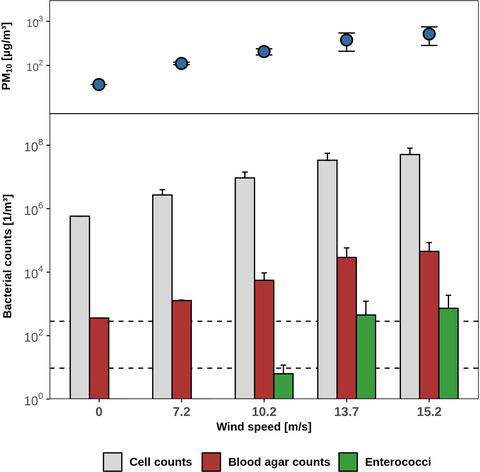当前位置:
X-MOL 学术
›
Microb. Biotechnol.
›
论文详情
Our official English website, www.x-mol.net, welcomes your feedback! (Note: you will need to create a separate account there.)
Airborne bacterial emission fluxes from manure-fertilized agricultural soil.
Microbial Biotechnology ( IF 5.7 ) Pub Date : 2020-07-22 , DOI: 10.1111/1751-7915.13632 Nadine Thiel 1 , Steffen Münch 2 , Wiebke Behrens 1 , Vera Junker 1 , Matthias Faust 3 , Oliver Biniasch 4 , Tina Kabelitz 4 , Paul Siller 5 , Christian Boedeker 1 , Peter Schumann 1 , Uwe Roesler 5 , Thomas Amon 4, 5 , Kerstin Schepanski 3 , Roger Funk 2 , Ulrich Nübel 1, 6, 7
Microbial Biotechnology ( IF 5.7 ) Pub Date : 2020-07-22 , DOI: 10.1111/1751-7915.13632 Nadine Thiel 1 , Steffen Münch 2 , Wiebke Behrens 1 , Vera Junker 1 , Matthias Faust 3 , Oliver Biniasch 4 , Tina Kabelitz 4 , Paul Siller 5 , Christian Boedeker 1 , Peter Schumann 1 , Uwe Roesler 5 , Thomas Amon 4, 5 , Kerstin Schepanski 3 , Roger Funk 2 , Ulrich Nübel 1, 6, 7
Affiliation

|
This is the first study to quantify the dependence on wind velocity of airborne bacterial emission fluxes from soil. It demonstrates that manure bacteria get aerosolized from fertilized soil more easily than soil bacteria, and it applies bacterial genomic sequencing for the first time to trace environmental faecal contamination back to its source in the chicken barn. We report quantitative, airborne emission fluxes of bacteria during and following the fertilization of agricultural soil with manure from broiler chickens. During the fertilization process, the concentration of airborne bacteria culturable on blood agar medium increased more than 600 000‐fold, and 1 m3 of air carried 2.9 × 105 viable enterococci, i.e. indicators of faecal contamination which had been undetectable in background air samples. Trajectory modelling suggested that atmospheric residence times and dispersion pathways were dependent on the time of day at which fertilization was performed. Measurements in a wind tunnel indicated that airborne bacterial emission fluxes from freshly fertilized soil under local climatic conditions on average were 100‐fold higher than a previous estimate of average emissions from land. Faecal bacteria collected from soil and dust up to seven weeks after fertilization could be traced to their origins in the poultry barn by genomic sequencing. Comparative analyses of 16S rRNA gene sequences from manure, soil and dust showed that manure bacteria got aerosolized preferably, likely due to their attachment to low‐density manure particles. Our data show that fertilization with manure may cause substantial increases of bacterial emissions from agricultural land. After mechanical incorporation of manure into soil, however, the associated risk of airborne infection is low.
中文翻译:

肥料施肥后的土壤中的空气传播细菌排放通量。
这是第一项量化土壤中空气传播的细菌排放通量对风速依赖性的研究。结果表明,粪肥细菌比土壤细菌更容易从肥沃的土壤中雾化,并且首次应用细菌基因组测序来追踪环境粪便污染源回到鸡舍中。我们报告了用肉鸡粪肥对农业土壤施肥期间和之后细菌的定量,空气传播排放通量。在施肥过程中,可在血琼脂培养基上培养的空气传播细菌的浓度增加了600,000倍以上,并且1 m 3的空气中载有2.9×10 5活的肠球菌,即在背景空气样本中无法检测到的粪便污染指标。轨迹模型表明,大气停留时间和扩散途径取决于施肥的时间。在风洞中进行的测量表明,在当地气候条件下,新鲜施肥土壤中的空气传播细菌排放通量平均比以前估计的土地平均排放量高100倍。受精后最多七周从土壤和灰尘中收集的粪便细菌可以通过基因组测序追溯到它们在禽舍中的起源。对粪便,土壤和灰尘中的16S rRNA基因序列进行的比较分析表明,粪便细菌最好被雾化,这可能是由于它们附着在低密度粪便颗粒上。我们的数据表明,肥料施肥可能导致农田中细菌排放的大量增加。但是,将肥料机械掺入土壤后,空气传播感染的相关风险很低。
更新日期:2020-07-22
中文翻译:

肥料施肥后的土壤中的空气传播细菌排放通量。
这是第一项量化土壤中空气传播的细菌排放通量对风速依赖性的研究。结果表明,粪肥细菌比土壤细菌更容易从肥沃的土壤中雾化,并且首次应用细菌基因组测序来追踪环境粪便污染源回到鸡舍中。我们报告了用肉鸡粪肥对农业土壤施肥期间和之后细菌的定量,空气传播排放通量。在施肥过程中,可在血琼脂培养基上培养的空气传播细菌的浓度增加了600,000倍以上,并且1 m 3的空气中载有2.9×10 5活的肠球菌,即在背景空气样本中无法检测到的粪便污染指标。轨迹模型表明,大气停留时间和扩散途径取决于施肥的时间。在风洞中进行的测量表明,在当地气候条件下,新鲜施肥土壤中的空气传播细菌排放通量平均比以前估计的土地平均排放量高100倍。受精后最多七周从土壤和灰尘中收集的粪便细菌可以通过基因组测序追溯到它们在禽舍中的起源。对粪便,土壤和灰尘中的16S rRNA基因序列进行的比较分析表明,粪便细菌最好被雾化,这可能是由于它们附着在低密度粪便颗粒上。我们的数据表明,肥料施肥可能导致农田中细菌排放的大量增加。但是,将肥料机械掺入土壤后,空气传播感染的相关风险很低。



























 京公网安备 11010802027423号
京公网安备 11010802027423号